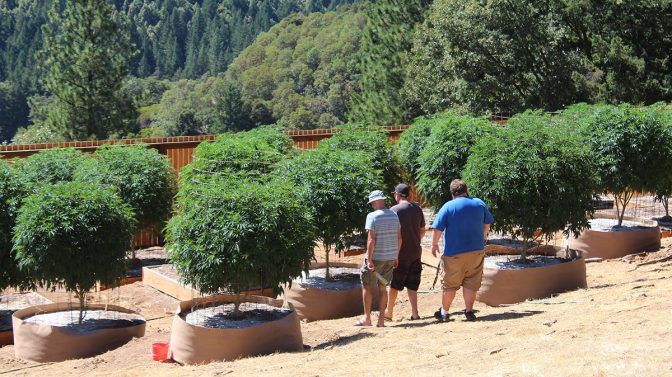Five Cannabis Innovations in Northern California

In the past 21 years, ever since medical marijuana was legalized in California, the Golden State has developed a significant cannabis industry. However, the lack of state regulations kept its size and growth rate in check. Now that recreational marijuana is finally available, many are wondering what the cannabis market in the world’s sixth-largest economy will eventually look like.
Northern California has taken a more active approach to cannabis regulations than its southern counterpart. This is partly due to necessity, since so much of the cannabis grown in California comes from the Emerald Triangle, the northwestern region made up of Mendocino, Humboldt and Trinity counties.
It was also due to culture. The Bay Area has the reputation of being one of the most progressive metropolitan areas in the world, from the Summer of Love in San Francisco to the liberal mecca of the University of California at Berkeley to the social-justice warriors of Oakland.
Here are five exciting things to look forward to in Northern California regarding cannabis:
Cannabis Lounges
In the early 2000s, Oakland had not yet officially banned public cannabis smoking. The city eventually did through a no-smoking ordinance, which outlaws public smoking and doesn’t limit the ban to tobacco (the state law specifies tobacco). While the law stands, Oakland has already shown its willingness to embrace social consumption by permitting a farmer’s market and dab bar at Magnolia Wellness. Similarly, in San Francisco, Harvest has a consumption lounge, and you can vaporize at SPARC. Prop 64 lets localities license on-site consumption at dispensaries. I predict the state will license standalone consumption lounges that also sell food and coffee.
Cannabis and…
Private events that mix marijuana with other fun activities are popular in the Bay Area, such as cannabis and yoga and cannabis and cooking. At Puff Puff Paint in Oakland, patrons sample cannabis and then create art with their brushes. And, while they haven’t formally organized events like “high hikes,” many northern California cannabis companies pitch their ad campaigns towards residents’ fondness for the outdoors. Some design waterproof bags to make it easier to take your herb with you on an adventure. With the state offering a cannabis-events license, I see more opportunities to combine pot with other activities—and not just by hot-boxing in the parking lot.

A Puff Pass Paint class in Oakland, Calif.
Cannabis Tourism
Many consumers, even those who’ve been ingesting cannabis for decades, have never seen a plant in the ground. This is primarily due to prohibition and the necessity that growing operations be kept secret. The product just showed up, in a baggie, and you paid whatever the person selling it charged. Not having any interaction with the farmer or the live plant has been to a detriment to consumers. Cannabis tourism will change that. Trips to the Emerald Triangle will be akin to wine-country vacations. Farm tours will include tastings and knowledge transmitted from farmer to consumer.
In the Bay Area, cannabis tourism is our chance to educate the public rather than just get them high, to teach safe and mindful consumption—so a couple visiting from Nebraska will be less likely to have a bad experience with an edible or a prerolled joint. Companies like Emerald Country Tours offer history and culture as well as vape hits. I expect to see much more cannabis tourism opportunities in the future, including those with allied industries like wine and food.
Farm-to-Table Craft Cannabis
Many of the small family pot farms in the Emerald Triangle are off the grid. Yes, the farmers care deeply about the environment, but this is also a result of prohibition, when detection was an issue. Now that prohibition’s over, these farmers are continuing their practices of solar power, water recycling and regenerative soil. They’re not only on the cutting edge of cannabis, but of modern-day food production as well. Organic methods and the use of living soils also set an example for the food industry.
Northern California is, hands down, the cannabis capital of the world.
In a prohibition market, there’s no way to discern quality from quantity, primarily because of lack of information about the product itself. In the age of legalization, consumers will be able to make better choices about what they consume. And, if the consumer is concerned about the impact of industrial agriculture on the environment, they can and should choose sun-grown, organic outdoor cannabis. Legalization could enable high-quality craft cultivators to take center stage. But we must be vigilant that the regulations are not overly burdensome on the small farmer, and that they enjoy the same tax incentives and direct-to-consumer opportunities as those in the beer and wine industries.
Incubator of Ideas
Northern California has been a leader in all things cannabis since the 1960s. In 1992, San Francisco voters passed Prop P, a ballot initiative promoted by AIDS activist Dennis Peron and others that made the medical use of cannabis the lowest law-enforcement priority. In 1996, Californians voted in favor of Prop 215, the first statewide medical-cannabis law in the country. In the East Bay, Berkeley has had the same three dispensaries for more than 20 years, and was one of the first jurisdictions to allow adult-use sales on Jan. 1. In 2011, when Oakland tried to move forward with licensing cultivation facilities, it received a threatening letter from the federal government. Oakland also created the state’s first cannabis-equity program, which gives priority to residents from lower economic backgrounds.
Oakland and Berkeley both sued the federal government when it threatened to shutter their largest dispensaries, Harborside Health Center and Berkeley Patients Group, in 2012. The Emerald Triangle has also tried some progressive cannabis policies, such as the 9.31 program in Mendocino County in 2010 that allowed farmers to register their plants with the Sheriff’s office. The Feds shut that down too.
Legalization has come to California and all of its 38 million residents. Much of the state will continue to be a dry, barren landscape of commercial cannabis bans and unworkable regulations. Some SoCal cities have created a framework for cannabis commerce. But, Northern California is, hands down, the cannabis capital of the world, and with 20 years of dipping their toes in regulations behind them, the Bay Area and Emerald Triangle are ready for the post-prohibition era.
This article appeared in Freedom Leaf Issue 31. If you enjoyed this article, subscribe to the magazine today!
Related Articles
Arcview Predicts $7.7 Billion California Cannabis Market by 2021
In Defense of Weedmaps’ Fight with California
Ngaio Bealum on Recreational Legalization in the Golden State
Equity in Oakland: Giving Minorities a Chance
